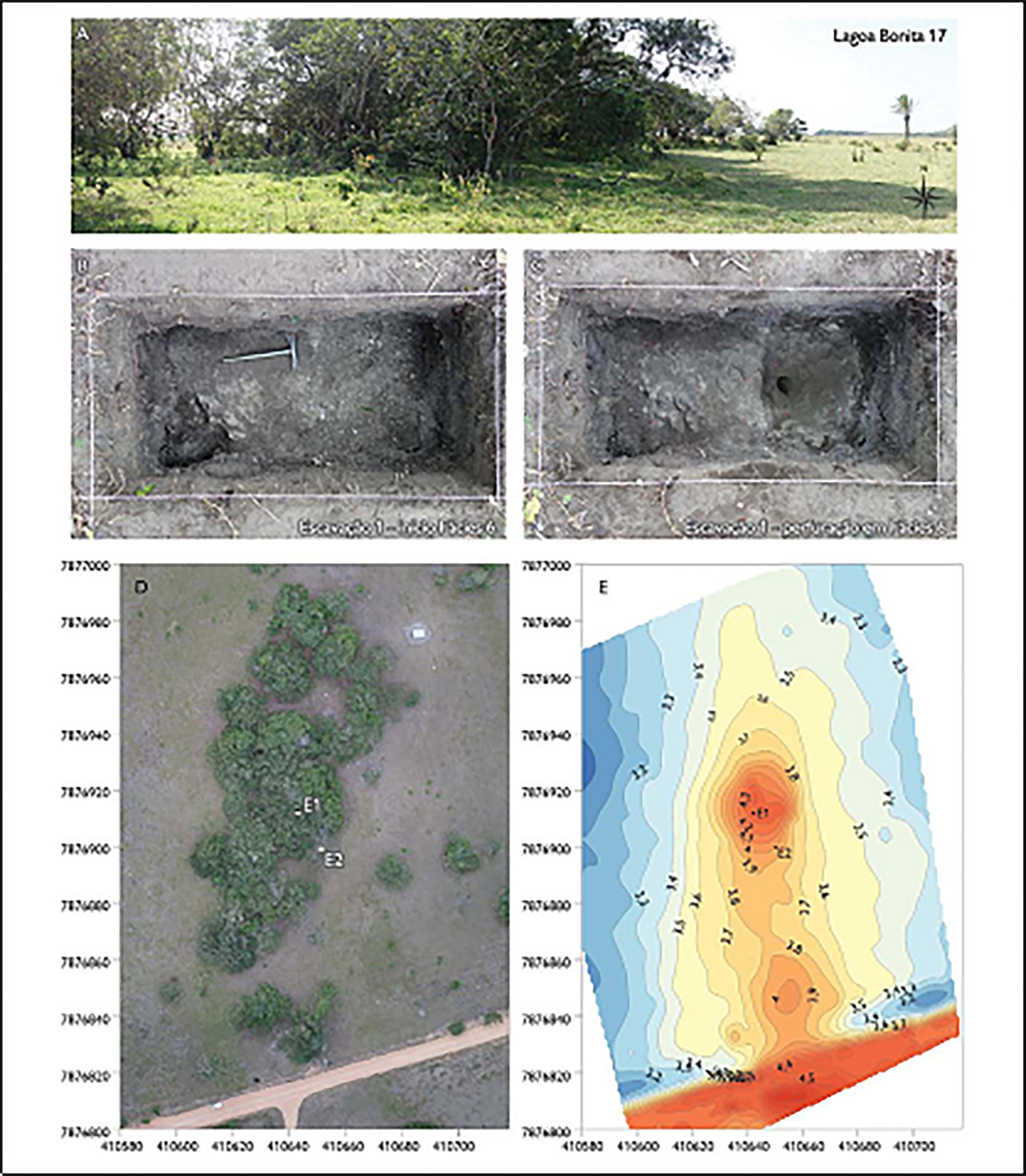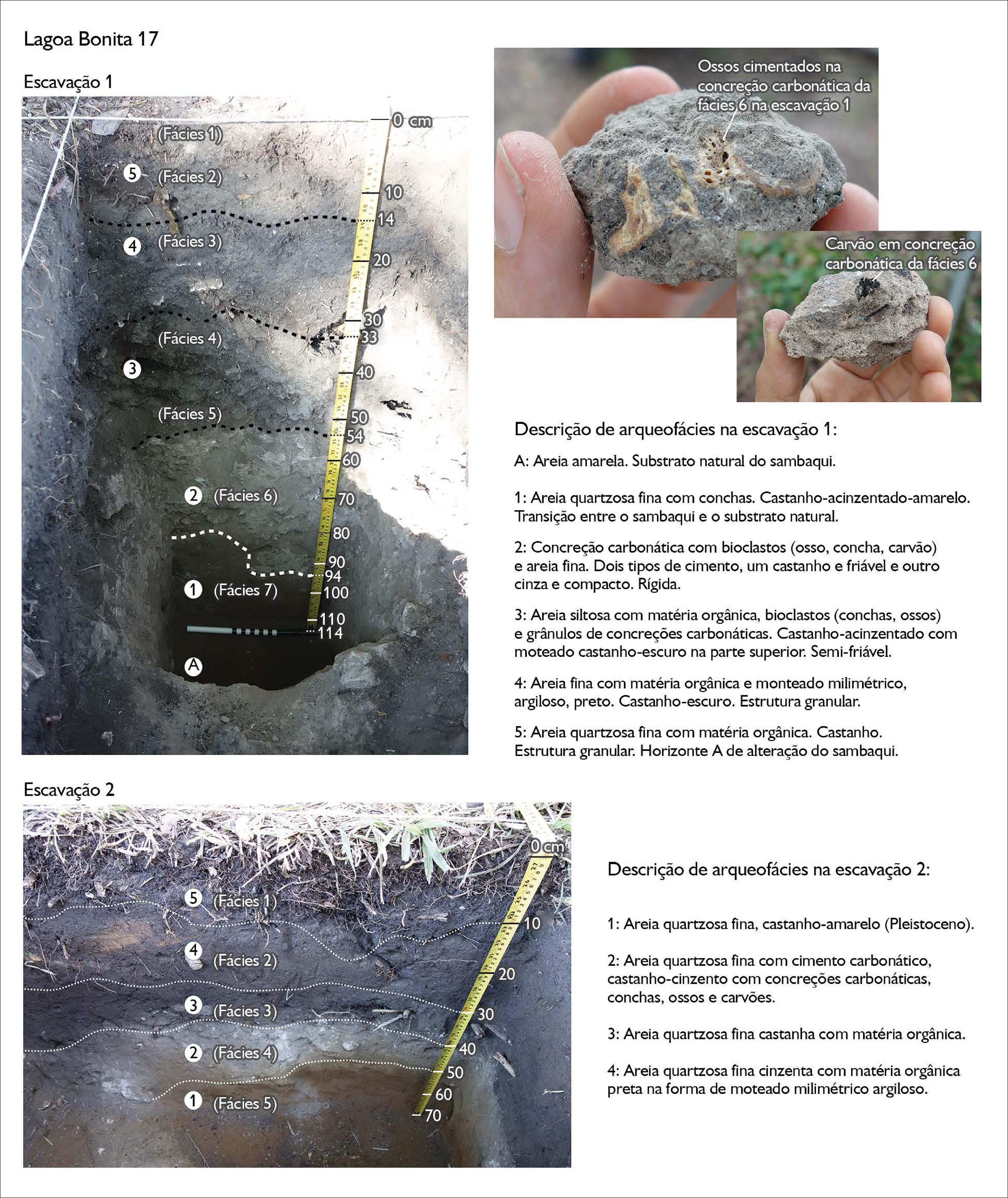| Areal 1 |
7931686 |
419098 |
Conceição da Barra |
Ambiental Norte (2001b)AMBIENTAL NORTE. Levantamento arqueológico na área do programa sísmico 3D Norte – ES. Relatório final. Processo 89/96, licença de operação 185/98. Linhares: Petrobrás, 2001b.
|
ES00173 |
|
| Areal 2 |
7931786 |
419148 |
Conceição da Barra |
Ambiental Norte (2001b)AMBIENTAL NORTE. Levantamento arqueológico na área do programa sísmico 3D Norte – ES. Relatório final. Processo 89/96, licença de operação 185/98. Linhares: Petrobrás, 2001b.
|
ES00174 |
|
| Fazenda Furado |
7933585 |
417449 |
Conceição da Barra |
Ambiental Norte (2001b)AMBIENTAL NORTE. Levantamento arqueológico na área do programa sísmico 3D Norte – ES. Relatório final. Processo 89/96, licença de operação 185/98. Linhares: Petrobrás, 2001b.
|
ES00177 |
|
| Fazenda Morcego |
7934185 |
417149 |
São Mateus |
Ambiental Norte (2001b)AMBIENTAL NORTE. Levantamento arqueológico na área do programa sísmico 3D Norte – ES. Relatório final. Processo 89/96, licença de operação 185/98. Linhares: Petrobrás, 2001b.
|
ES00178 |
|
| Ilha Preta |
7916490 |
417998 |
São Mateus |
Ambiental Norte (2001b)AMBIENTAL NORTE. Levantamento arqueológico na área do programa sísmico 3D Norte – ES. Relatório final. Processo 89/96, licença de operação 185/98. Linhares: Petrobrás, 2001b.
|
ES00095 |
|
| Ranchinho |
7920489 |
418848 |
São Mateus |
Ambiental Norte (2001b)AMBIENTAL NORTE. Levantamento arqueológico na área do programa sísmico 3D Norte – ES. Relatório final. Processo 89/96, licença de operação 185/98. Linhares: Petrobrás, 2001b.
|
ES00144 |
|
| Fazenda Rio Doce |
7873953 |
409944 |
Linhares |
Ambiental Norte (2001a)AMBIENTAL NORTE. Levantamento arqueológico na área do programa sísmico 3D São Jorge Sul – ES. Relatório final. Processo 89/96, licença de operação 185/98. Linhares: Petrobrás, 2001a.
|
ES00149 |
|
| Zacarias 1 |
7849049 |
418713 |
Linhares |
Ambiental Norte (2005a)AMBIENTAL NORTE. Levantamento arqueológico na área do programa sísmico 3D “BT-ES-14” – Linhares (ES). Relatório final. Licença de operação GAI/N.013/2002/Classe IV. Linhares: Petrobrás, 2005a.
|
s/c |
|
| Zacarias 2 |
7846730 |
417032 |
Linhares |
Ambiental Norte (2005a)AMBIENTAL NORTE. Levantamento arqueológico na área do programa sísmico 3D “BT-ES-14” – Linhares (ES). Relatório final. Licença de operação GAI/N.013/2002/Classe IV. Linhares: Petrobrás, 2005a.
|
s/c |
|
| Suruaca 13 |
7880418 |
414938 |
Linhares |
Ambiental Norte (2005b)AMBIENTAL NORTE. Levantamento arqueológico na área do programa sísmico 3D “BT-ES-22” – Linhares (ES). Relatório final. Licença de operação GAI/N.013/2002/Classe IV. Linhares: Petrobrás, 2005b.
|
s/c |
|
| Suruaca 19 |
7876559 |
415277 |
Linhares |
Ambiental Norte (2005b)AMBIENTAL NORTE. Levantamento arqueológico na área do programa sísmico 3D “BT-ES-22” – Linhares (ES). Relatório final. Licença de operação GAI/N.013/2002/Classe IV. Linhares: Petrobrás, 2005b.
|
s/c |
Ossos, areia e MO |
| Suruaca 20 |
7873742 |
410101 |
Linhares |
Ambiental Norte (2005b)AMBIENTAL NORTE. Levantamento arqueológico na área do programa sísmico 3D “BT-ES-22” – Linhares (ES). Relatório final. Licença de operação GAI/N.013/2002/Classe IV. Linhares: Petrobrás, 2005b.
|
ES00314 |
Sambaqui |
| Lagoa Bonita 1 – Morro do Mutum |
7882137 |
412095 |
Linhares |
s/ref. |
ES00317 |
Sambaqui |
| Lagoa Bonita 2 |
7881072 |
413153 |
Linhares |
s/ref. |
s/c |
Sambaqui |
| Lagoa Bonita 6 |
7878098 |
413149 |
Linhares |
Ambiental Norte (2005b)AMBIENTAL NORTE. Levantamento arqueológico na área do programa sísmico 3D “BT-ES-22” – Linhares (ES). Relatório final. Licença de operação GAI/N.013/2002/Classe IV. Linhares: Petrobrás, 2005b.
|
s/c |
Sambaqui |
| Lagoa Bonita 7 |
7876598 |
414166 |
Linhares |
Ambiental Norte (2005b)AMBIENTAL NORTE. Levantamento arqueológico na área do programa sísmico 3D “BT-ES-22” – Linhares (ES). Relatório final. Licença de operação GAI/N.013/2002/Classe IV. Linhares: Petrobrás, 2005b.
|
s/c |
Sambaqui |
| Lagoa Bonita 8 |
7881207 |
405557 |
Linhares |
Ambiental Norte (2005b)AMBIENTAL NORTE. Levantamento arqueológico na área do programa sísmico 3D “BT-ES-22” – Linhares (ES). Relatório final. Licença de operação GAI/N.013/2002/Classe IV. Linhares: Petrobrás, 2005b.
|
s/c |
|
| Lagoa Bonita 9 |
7876257 |
414413 |
Linhares |
Ambiental Norte (2005b)AMBIENTAL NORTE. Levantamento arqueológico na área do programa sísmico 3D “BT-ES-22” – Linhares (ES). Relatório final. Licença de operação GAI/N.013/2002/Classe IV. Linhares: Petrobrás, 2005b.
|
s/c |
Sem material |
| Lagoa Bonita 10 |
7875883 |
414545 |
Linhares |
Ambiental Norte (2005b)AMBIENTAL NORTE. Levantamento arqueológico na área do programa sísmico 3D “BT-ES-22” – Linhares (ES). Relatório final. Licença de operação GAI/N.013/2002/Classe IV. Linhares: Petrobrás, 2005b.
|
s/c |
|
| Lagoa Bonita 11 |
7873784 |
415717 |
Linhares |
Ambiental Norte (2005b)AMBIENTAL NORTE. Levantamento arqueológico na área do programa sísmico 3D “BT-ES-22” – Linhares (ES). Relatório final. Licença de operação GAI/N.013/2002/Classe IV. Linhares: Petrobrás, 2005b.
|
s/c |
|
| Lagoa Bonita 12 |
7875074 |
414423 |
Linhares |
Ambiental Norte (2005b)AMBIENTAL NORTE. Levantamento arqueológico na área do programa sísmico 3D “BT-ES-22” – Linhares (ES). Relatório final. Licença de operação GAI/N.013/2002/Classe IV. Linhares: Petrobrás, 2005b.
|
s/c |
|
| Lagoa Bonita 13 |
7876662 |
413545 |
Linhares |
Ambiental Norte (2005b)AMBIENTAL NORTE. Levantamento arqueológico na área do programa sísmico 3D “BT-ES-22” – Linhares (ES). Relatório final. Licença de operação GAI/N.013/2002/Classe IV. Linhares: Petrobrás, 2005b.
|
s/c |
Ossos, areia e MO |
| Lagoa Bonita 14 |
7876214 |
415859 |
Linhares |
Ambiental Norte (2005b)AMBIENTAL NORTE. Levantamento arqueológico na área do programa sísmico 3D “BT-ES-22” – Linhares (ES). Relatório final. Licença de operação GAI/N.013/2002/Classe IV. Linhares: Petrobrás, 2005b.
|
s/c |
Sem material |
| Lagoa Bonita 15 |
7876097 |
413899 |
Linhares |
Ambiental Norte (2005b)AMBIENTAL NORTE. Levantamento arqueológico na área do programa sísmico 3D “BT-ES-22” – Linhares (ES). Relatório final. Licença de operação GAI/N.013/2002/Classe IV. Linhares: Petrobrás, 2005b.
|
s/c |
|
| Lagoa Bonita 16 |
7871454 |
413338 |
Linhares |
Ambiental Norte (2005b)AMBIENTAL NORTE. Levantamento arqueológico na área do programa sísmico 3D “BT-ES-22” – Linhares (ES). Relatório final. Licença de operação GAI/N.013/2002/Classe IV. Linhares: Petrobrás, 2005b.
|
s/c |
Ossos, areia e MO |
| Lagoa Bonita 17 |
7876980 |
410659 |
Linhares |
Ambiental Norte (2005b)AMBIENTAL NORTE. Levantamento arqueológico na área do programa sísmico 3D “BT-ES-22” – Linhares (ES). Relatório final. Licença de operação GAI/N.013/2002/Classe IV. Linhares: Petrobrás, 2005b.
|
s/c |
|
| Lagoa Bonita 18 |
7873524 |
413407 |
Linhares |
Ambiental Norte (2005b)AMBIENTAL NORTE. Levantamento arqueológico na área do programa sísmico 3D “BT-ES-22” – Linhares (ES). Relatório final. Licença de operação GAI/N.013/2002/Classe IV. Linhares: Petrobrás, 2005b.
|
s/c |
Sem material |
| Lagoa Bonita 19* |
7870979 |
412348 |
Linhares |
Ambiental Norte (2005b)AMBIENTAL NORTE. Levantamento arqueológico na área do programa sísmico 3D “BT-ES-22” – Linhares (ES). Relatório final. Licença de operação GAI/N.013/2002/Classe IV. Linhares: Petrobrás, 2005b.
|
ES00316 |
Ossos, areia e MO |
| Lagoa Bonita 20* |
7871097 |
412371 |
Linhares |
Ambiental Norte (2005b)AMBIENTAL NORTE. Levantamento arqueológico na área do programa sísmico 3D “BT-ES-22” – Linhares (ES). Relatório final. Licença de operação GAI/N.013/2002/Classe IV. Linhares: Petrobrás, 2005b.
|
ES00316 |
Ossos, areia e MO |
| Lagoa Bonita 21 |
7866817 |
400955 |
Linhares |
Ambiental Norte (2005b)AMBIENTAL NORTE. Levantamento arqueológico na área do programa sísmico 3D “BT-ES-22” – Linhares (ES). Relatório final. Licença de operação GAI/N.013/2002/Classe IV. Linhares: Petrobrás, 2005b.
|
s/c |
|
| Lagoa Bonita 22* |
7871350 |
412295 |
Linhares |
Ambiental Norte (2005b)AMBIENTAL NORTE. Levantamento arqueológico na área do programa sísmico 3D “BT-ES-22” – Linhares (ES). Relatório final. Licença de operação GAI/N.013/2002/Classe IV. Linhares: Petrobrás, 2005b.
|
s/c |
Ossos, areia e MO |
| Lagoa Bonita 23* |
7871208 |
412426 |
Linhares |
Ambiental Norte (2005b)AMBIENTAL NORTE. Levantamento arqueológico na área do programa sísmico 3D “BT-ES-22” – Linhares (ES). Relatório final. Licença de operação GAI/N.013/2002/Classe IV. Linhares: Petrobrás, 2005b.
|
ES00316 |
|
| Lagoa Bonita 24/25 |
7870464 |
411389 |
Linhares |
Ambiental Norte (2005c)AMBIENTAL NORTE. Levantamento arqueológico na área do programa sísmico 3D “BT-ES-27” – Linhares (ES). Relatório final. Licença de operação GAI/N.013/2002/Classe IV. Linhares: Petrobrás, 2005c.
|
ES00315 |
Sambaqui |
| Lagoa Bonita 26 |
7871023 |
408677 |
Linhares |
Ambiental Norte (2005c)AMBIENTAL NORTE. Levantamento arqueológico na área do programa sísmico 3D “BT-ES-27” – Linhares (ES). Relatório final. Licença de operação GAI/N.013/2002/Classe IV. Linhares: Petrobrás, 2005c.
|
s/c |
|
| Barro Novo 1 |
7866525 |
409020 |
Linhares |
Ambiental Norte (2005c)AMBIENTAL NORTE. Levantamento arqueológico na área do programa sísmico 3D “BT-ES-27” – Linhares (ES). Relatório final. Licença de operação GAI/N.013/2002/Classe IV. Linhares: Petrobrás, 2005c.
|
s/c |
Sambaqui |
| Ponte da Suruaca |
7883166 |
42367 |
Linhares |
Fundação Seridó (2006)FUNDAÇÃO SERIDÓ. Relatório final da prospecção arqueológica na área de implantação do gasoduto Cacimbas-Catu. Recife, 2006.
|
ES00206 |
Sambaqui |






